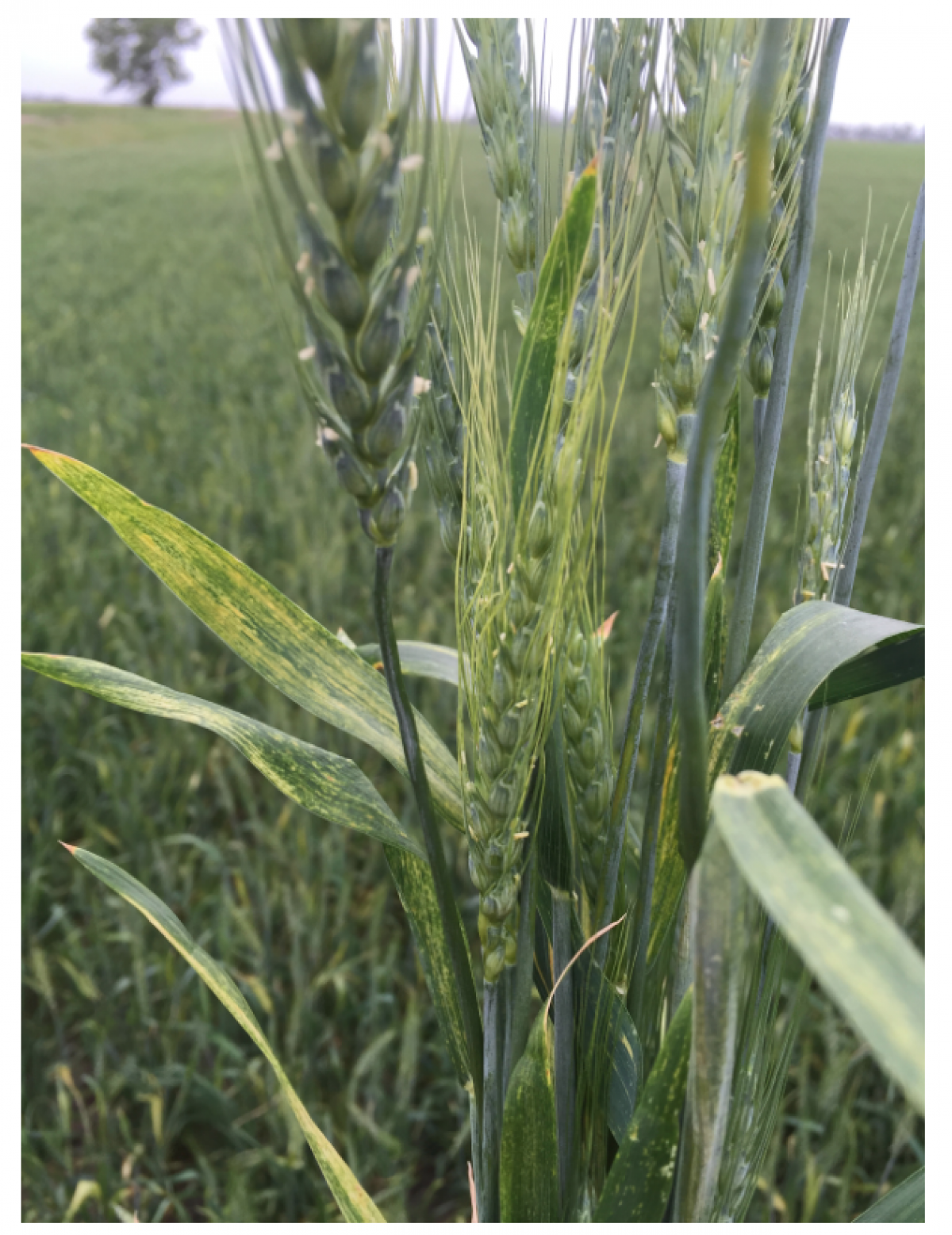Identifying cereal leaf diseases
Correctly identifying foliar diseases is important for managing them effectively and efficiently. It is important to take note of moisture conditions, as well as the physical symptoms of the plants, in order to correctly identify diseases. Management practices such as growing resistant varieties, lengthening rotations, using clean and healthy seed, scouting your fields, and being aware of conditions in the surrounding area are the first steps towards managing diseases.
Net blotch (spotted and netted)

Fig. 1
Environment: Thrives in warm, moist conditions
Crops affected: Barley
Symptoms:
- Starts as small brown lesions
- Netted form: the small brown lesions elongate and typically run parallel to the leaf veins. Darker lines may develop between long narrow streaks producing a netted appearance (Figure 1)
- Spotted form: the small brown lesions can enlarge, but typically maintain an oval shape and do not elongate (Figure 2)
- Yellow (chlorotic) tissues may form a border surrounding the brown (dead) tissue.

Fig. 2
Spotted net blotch is often confused with: Spot blotch which produces oval-shaped dark brown lesions (note a laboratory test is typically needed to tell the two diseases apart)
Control options1: Numerous options available, such as metconazole (group 3), benzovindiflupyr (group 7) and azoxystrobin (group 11)
Scald

Fig. 3
Environment: Thrives in cool and wet or rainy conditions
Crops affected: Barley
Symptoms:
- Begins as water soaked grey-green spots on leaves
- Turns into oval spots (Figure 3)
- The centre of the spot may become a tan color and dry (with a dark purple-brown margin)
- Control options1: Numerous options available, such as propiconazole (group 3), fluxapyroxad (group 7) and pyraclostrobin (group 11)
Stripe Rust (Yellow rust)
Crops affected: Wheat, triticale, barley
Symptoms:

Fig. 4
Environment: Thrives in cool-warm and wet conditions
- Long chains of yellow pustules on leaves that turn darker as they age and the crop matures (Figure 4)
- May result in complete destruction of healthy leaf tissue
- Often confused with: Stem or leaf rust (note the colour, organization and location—stripe rust is yellow-orange, organized in stripes and is mainly found on leaves, while stem and leaf rust is brick-red, lacks organization, stem rust is found mainly on stem)
- Control options1: Numerous options available, such as tebuconazole (group 3), fluxapyroxad (group 7) and azoxystrobin (group 11)
Wheat Streak Mosaic Virus

- Light green/yellow streaks on young leaves that can spread until it covers the entire leaf (Figure 5)
- Mostly found on field margins due to spread by wheat curl mite
- Stunted plant growth, early infected plants (seedlings) may die before head emergence
Control options1: Caused by a virus, not a fungus, and cannot be controlled by spraying fungicide. Thus, prevention is key. Prevent wheat streak mosaic virus carry over from spring to winter crops or vice versa (limit the occurrence of a green bridge of living host tissue), especially volunteer spring cereals in the fall
Spot blotch

Fig. 6
Environment: Thrives in warm, moist conditions
Crops affected: Wheat, barley
Symptoms:
- Same pathogen causes kernel smudge/black point, seedling blight, and common root rot
- Dark spots may occur on other parts of the plant (leaf sheaths, necks, heads)
- Elliptical shaped spots with distinct margins (sometimes of yellow chlorotic tissue)
- Brown spots on leaves, uniformly coloured (Figure 6)
- Often confused with: Spotted net blotch (note a laboratory test is typically needed to tell the two diseases apart)
- Control options1: Options such as metconazole (group 3), fluxapyroxad (group 7) and pyraclostrobin (group 11)
Tan spot (Yellow leaf spot)
Symptoms:

Fig. 7
Environment: Thrives in warm, moist conditions
Crops affected: Wheat
- Small tan coloured spots appear on lower leaves then move to the middle and upper canopy leaves (Figure 7)
- Yellow chlorotic margin may occur, while the centre area of individual lesions may have a darker colour, but are not dotted with black-brown fruiting bodies like the septoria complex
- Spots join to form irregular shaped blotches if severe
Control options1: Numerous options available, including metconazole (group 3), picoxystrobin (group 11) and chlorothalonil (group M)
Stem rust (Black rust) and leaf rust

Fig. 8
Environment: Thrives in warm, moist conditions
Crops affected: Wheat, triticale, barley
Symptoms:
- Red pustules found on stems (stem rust) or leaves (leaf rust), darken as they age
- Apparent peeling of stem accompanying pustules (stem rust) (Figure 8)
- Stem rust is not often found on leaves, while leaf rust is mainly confined to leaf tissues
Often confused with: Stripe rust (note the colour, organization and location—stripe rust is yellow-orange, organized in stripes and is mainly found on leaves, stem and leaf rust is brick-red, lacks organization and stem rust is found mainly on stem)
Control options1: Options such as propiconazole (group 3) or fluoxastrobin (group 11)
1Refer to the Crop Protection guide (Blue Book) for more information about active ingredients.
Always read and follow product labels.
For further descriptions, please refer to the Spotlight on Diseases booklet.
Photos provided by Dr. Kelly Turkington and Dr. Tom Fetch.

